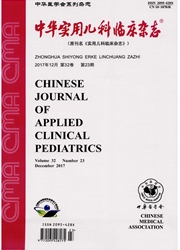

 中文摘要:
中文摘要:
目的 了解不同年龄组特应性皮炎(atopic dermatitis,AD)患儿血清变应原特异性免疫球蛋白E(sIgE)阳性检出率的分布特征,为临床评估患儿过敏状态及指导变应原回避提供参考.方法 选取90例变应原初筛检测有2种及2种以上变应原阳性的AD患儿.其中男66例,女24例;年龄0.3~16.1岁.年龄分组为0~3岁组(48例)、4~7岁组(31例)和8~16岁组(11例).临床诊断单纯AD患儿30例、合并哮喘或鼻炎的AD患儿60例.应用UniCAP250变应原定量IgE检测系统测定29种吸入性变应原和食物变应原sIgE水平.结果 各食物变应原阳性检出率为鸡蛋白55.6%(50/90例)、牛奶42.2%(38/90例)、蛋黄32.2% (29/90例)、虾12.2%(11/90例)、蟹11.1%(10/90例)、鸡肉7.8%(7/90例)、鱼4.4%(4/90例)、小麦54.4%(49/90例)、花生37.8%(34/90例)、大豆34.4%(31/90例)、西红柿33.3%(30/90例)、桃28.9%(26/90例);各吸入性变应原阳性检出率为屋尘51.1%(46/90例)、链格孢45.6%(41/90例)、户尘螨41.1%(37/90例)、粉尘螨40.0%(36/90例)、狗毛屑33.3%(30/90例)、蟑螂28.9%(26/90例)、猫上皮27.8%(25/90例)、热带无爪螨21.9%(19/90例)、豚草36.7%(33/90例)、美国白蜡34.4%(31/90例)、英国梧桐32.2%(29/90例)、北艾32.2%(29/90例)、疣皮桦31.1%(28/90例)、柳树27.8%(25/90例)、刺柏25.6%(23/90例)、葎草25.6%(23/90)例、藜25.6%(23/90例).0~3岁组患儿在鸡蛋白、牛奶和蛋黄的阳性检出率显著高于4~7岁组和8 ~16岁组,差异均有统计学意义(x2=29.27、15.98、18.58,P均<0.05);8~16岁组患儿户尘螨、粉尘螨、热带无爪螨、猫上皮、刺柏、葎草的阳性检出率均显著高于0~3岁组和4~7岁组患儿,差异均有统计学意义(x2=12.94、14.31、7.77、7.65、9.41、6.93,P均<0.05).单纯AD组患儿主要检出食物?
 英文摘要:
英文摘要:
Objective To investigate the distribution characteristics in the positive ratio distribution of serum allergen specific immunoglobulin E (sIgE) in atopic dermatitis children with multiple sensitization factors,which could help to assess the atopic condition and offer recommendation for the avoidance of allergens.Methods A total of 90 children with atopic dermatitis were enrolled(male 66,female 24,aged 0.3-16.1 years).All the patients were divided into 3 groups according to the patients' age:0-3 years old group (48 patients),4-7 years old group (31 patients),8-16 years old group (11 patients).The serum sIgE levels of 29 kinds of food and inhalation allergens in each patient were detected by the UniCAP 250 quantified IgE measurement system.Results The positive ratio of each food allergen in all the patients were as follows:55.6% (50/90 cases) for egg white,42.2% (38/90 cases) for milk,32.2% (29/90 cases) for egg yolk,12.2% (11/90 cases) for shrimp,11.1% (10/90 cases) for crab,7.8% (7/90 cases) for chicken,4.4% (4/90 cases) for fish,54.4% (49/90 cases) for wheat,37.8% (34/90 cases) for peanut,34.4% (31/90 cases) for soybean,33.3% (30/90 cases) for tomato and 28.9% (26/90 cases) for peach.The positive ratio of each inhalation allergen in all the patients were as follows:51.1% (46/90 cases) for house dust,45.6% (41/90 cases) for alternaria alternata,41.1% (37/90 cases) for dermatophagoides pteronyssinus,40% (36/90 cases) for dermatophagoides farinae,33.3% (30/90 cases) for dog dander,28.9% (26/90 cases) for cockroach,27.8% (25/90 cases) for cat dander,21.9% (19/90 cases) for blomia tropicalis,36.7% (33/90 cases) for ambrosia elatior,34.4% (31/90 cases) for white ash,32.2% (29/90 cases) for london plane,32.2% (29/90 cases) for artemisia vulgaris,31.1% (28/90 cases) for common silver birch,27.8% (25/90 cases) for willow,25.6% (23/90 ca
 同期刊论文项目
同期刊论文项目
 同项目期刊论文
同项目期刊论文
 期刊信息
期刊信息
